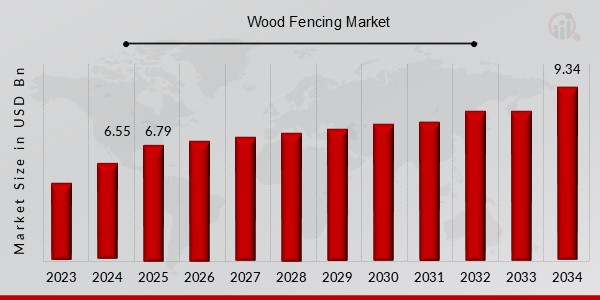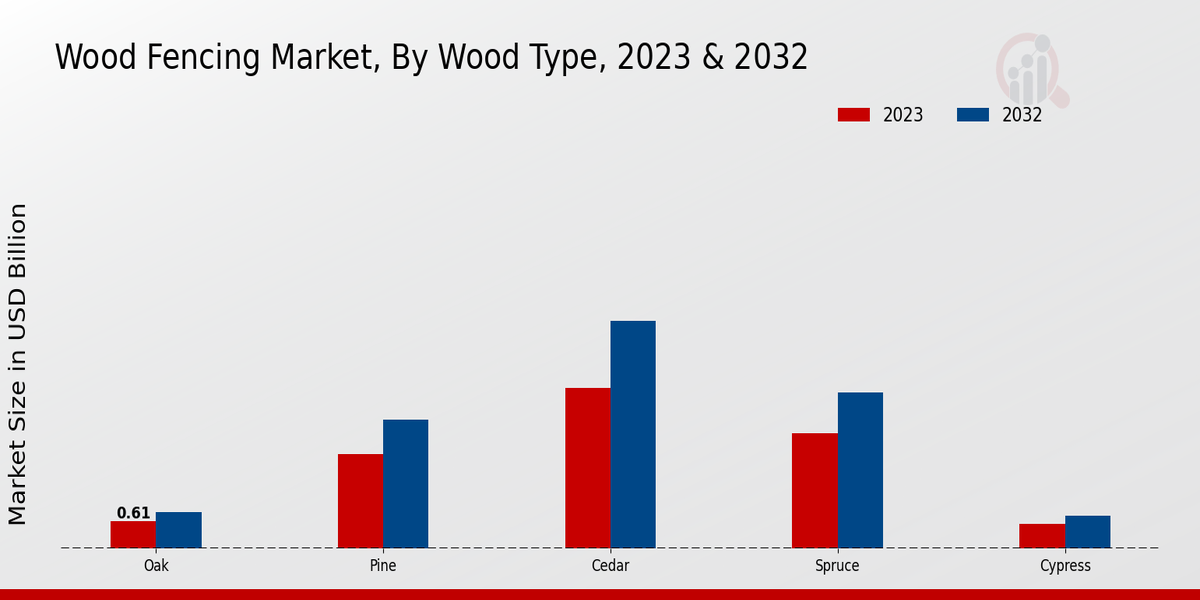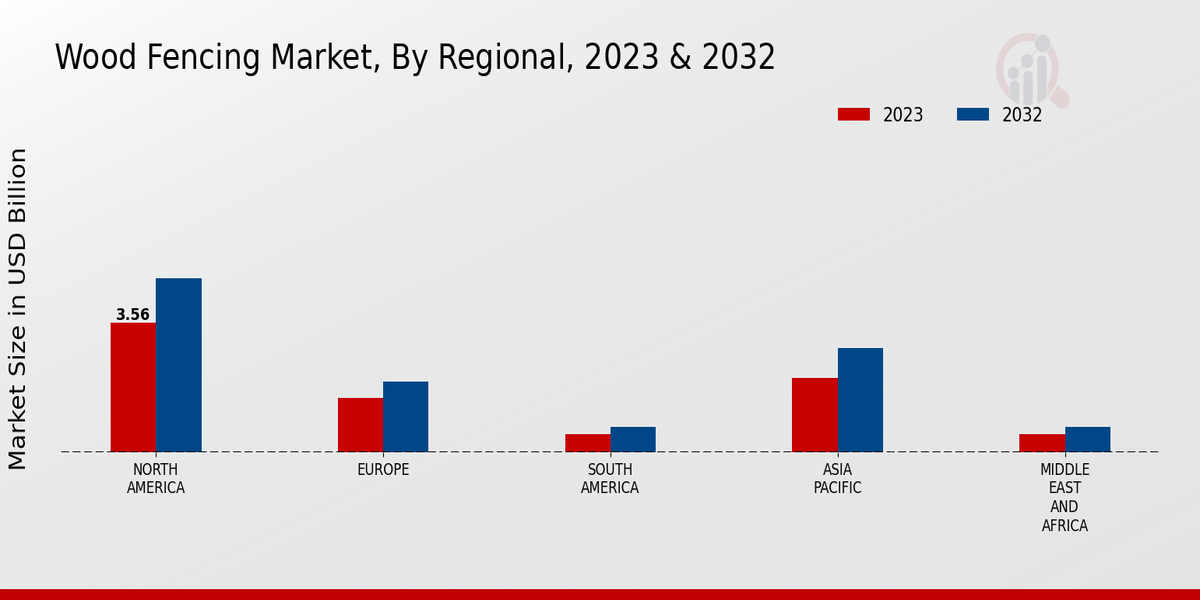Global Wood Fencing Market Overview
The Wood Fencing Market Size was estimated at 6.55 (USD Billion) in 2024. The Wood Fencing Industry is expected to grow from 6.79 (USD Billion) in 2025 to 9.34 (USD Billion) by 2034. The Wood Fencing Market CAGR (growth rate) is expected to be around 3.61% during the forecast period (2025 - 2034).
Key Wood Fencing Market Trends Highlighted
The Wood Fencing Market is set to witness substantial growth in the coming years, driven primarily by increasing demand for sustainable and aesthetically pleasing fencing solutions, rising construction spending, and a growing focus on outdoor living spaces. The shift towards eco-friendly and durable materials, such as wood, has fueled the adoption of wood fencing across residential and commercial properties. Moreover, the increasing prevalence of smart home technologies has created opportunities for the integration of automated fencing systems, enhancing security and convenience.

Source: Primary Research, Secondary Research, MRFR Database and Analyst Review
Wood Fencing Market Drivers
Rising Popularity of Outdoor Living Spaces
The growing trend of homeowners and commercial property owners investing in outdoor living spaces has significantly contributed to the growth of the Wood Fencing Market Industry. As people spend more time outdoors, they seek ways to enhance their outdoor areas, making wood fencing a popular choice due to its aesthetic appeal, durability, and privacy benefits. The increasing demand for outdoor living spaces is expected to continue driving the market growth in the coming years.
Increasing Demand for Sustainable Building Materials
The growing awareness of environmental sustainability has led to an increased demand for eco-friendly building materials, including wood fencing. Wood is a renewable resource that offers several environmental benefits, such as carbon sequestration and reduced greenhouse gas emissions. As more consumers and businesses prioritize sustainability, the demand for wood fencing is anticipated to rise, positively impacting the Wood Fencing Market Industry.
Growing Popularity of Wood Fencing in Commercial Applications
In addition to residential properties, wood fencing is gaining popularity in commercial applications. Businesses and organizations utilize wood fencing for various purposes, including perimeter security, crowd control, and privacy screening. The versatility and customization options of wood fencing make it a suitable choice for a wide range of commercial properties, contributing to the overall market growth.
Wood Fencing Market Segment Insights
Wood Fencing Market Wood Type Insights
The Wood Fencing Market is expected to grow significantly in the coming years, driven by increasing demand for privacy, security, and aesthetics in residential and commercial properties. The market is segmented based on wood type, with cedar, redwood, pine, oak, spruce, and cypress being the most commonly used materials. Cedar is a popular choice for wood fencing due to its natural resistance to rot, decay, and insects. It is also known for its beautiful reddish-brown color and its ability to withstand harsh weather conditions. Redwood is another durable wood that is resistant to rot and decay.It is naturally fire-resistant and has a beautiful reddish-brown color. Pine is a more affordable option that is commonly used for fencing in residential areas. It is not as durable as cedar or redwood, but it is still a good choice for areas with mild climates. Oak is a strong and durable wood that is often used for fencing in commercial and industrial areas. It is resistant to rot, decay, and insects, and it has a beautiful golden brown color. Spruce is a lightweight and affordable wood that is commonly used for fencing in residential areas.It is not as durable as cedar or redwood, but it is still a good choice for areas with mild climates. Cypress is a durable wood that is resistant to rot, decay, and insects. The market is expected to be driven by increasing demand for privacy, security, and aesthetics in residential and commercial properties. The market is also expected to benefit from the growing popularity of sustainable building materials.

Source: Primary Research, Secondary Research, MRFR Database and Analyst Review
Wood Fencing Market Design Insights
The Design segment of the Wood Fencing Market comprises various styles that cater to specific aesthetic preferences and functional requirements. Picket fences, with their classic pointed tops, offer a charming and decorative touch to residential properties. Privacy fences, characterized by solid panels, provide seclusion and noise reduction, making them ideal for backyard spaces. Split rail fences, featuring horizontal rails supported by vertical posts, exude a rustic and traditional appeal, often used in rural and agricultural settings. Lattice fences, with their interwoven diamond-shaped patterns, allow for airflow and visibility while still providing some privacy.Framed fences, featuring panels set within a frame, offer a more formal and sophisticated look, suitable for both residential and commercial applications. Privacy fences are expected to dominate the market, accounting for a significant share, driven by increasing demand for seclusion and noise reduction in residential and commercial properties. Picket fences are also anticipated to witness steady growth due to their enduring charm and aesthetic appeal. The growing popularity of outdoor living spaces is expected to boost the demand for framed and louvered fences, which offer both privacy and functionality.
Wood Fencing Market Height Insights
The Wood Fencing Market size is expected to reach USD 6.11 billion in 2023 and is projected to grow at a CAGR of 3.61% from 2023 to 2032. The market is segmented by height into under 6 feet, 6-8 feet, 8-10 feet, and over 10 feet. The under 6 feet segment accounted for the largest share of the Wood Fencing Market in 2023 and is projected to continue to dominate the market throughout the forecast period. This segment is primarily driven by the increasing popularity of picket fences and other short fences for residential applications.The 6-8 feet segment is projected to grow at a steady pace over the forecast period, as it is commonly used for both residential and commercial applications. The 8-10 feet segment is expected to witness significant growth, particularly in the commercial sector, as it is ideal for providing security and privacy. The over 10 feet segment is projected to grow at a slower pace, as it is typically used for specialized applications such as military bases and prisons.
Wood Fencing Market End-Use Insights
The end-use segment of the Wood Fencing Market is categorized into Residential, Commercial, Agricultural, and Industrial sectors. Each segment presents distinct market dynamics and growth prospects. Residential fencing accounts for around 60% of the Wood Fencing Market revenue. Rising homeowner interest in enhancing outdoor living spaces and increasing demand for privacy and security contribute to the dominance of this segment. Commercial fencing, on the other hand, is projected to witness steady growth due to rising construction activities and infrastructure development.The Agricultural segment holds a significant market share due to the extensive use of wood fencing for livestock containment and pasture management. Industrial fencing, though a smaller segment, also exhibits growth potential driven by increasing demand for safety and security in industrial facilities. Overall, the End Use segment offers a diverse landscape with varying growth opportunities, reflecting the diverse needs of end-users across different sectors.
Wood Fencing Market Treatment Insights
The Wood Fencing Market is segmented based on Treatment into Pressure-treated, Stained, Painted, Natural, and Composite. The Pressure-treated segment held the largest market share in 2023, accounting for over 40% of the Wood Fencing Market revenue. The growth of this segment can be attributed to the increasing demand for durable and low-maintenance fencing solutions. The Stained segment is expected to witness significant growth over the forecast period, owing to the rising popularity of aesthetically pleasing fencing options. The Painted segment is also expected to grow steadily, driven by the increasing demand for customized fencing solutions.The Natural segment is expected to remain stable over the forecast period, while the Composite segment is expected to witness moderate growth owing to its high cost and limited availability.
Wood Fencing Market Regional Insights
The regional segmentation of the Wood Fencing Market offers valuable insights into the geographical distribution of market revenue and growth patterns. North America is projected to dominate the market with a significant revenue share, owing to the increasing demand for wood fencing in residential and commercial construction. Europe is another key region driven by growing awareness of sustainability and the aesthetic appeal of wood fencing. The Asia-Pacific region is poised for significant growth, fueled by urbanization and rising disposable incomes.South America and the Middle East and Africa (MEA) also present growth opportunities, with increasing demand for wood fencing in residential and infrastructure projects.

Source: Primary Research, Secondary Research, MRFR Database and Analyst Review
Wood Fencing Market Key Players And Competitive Insights
Major players in the Wood Fencing Market industry are constantly striving for technological advancements and product innovation to maintain their competitive edge. Leading Wood Fencing Market players are focusing on expanding their distribution channels and geographical reach to cater to a broader customer base. The Wood Fencing Market development is driven by increasing consumer demand for aesthetic and durable fencing solutions for residential and commercial properties. The competitive landscape is characterized by a healthy mix of established players and emerging businesses, leading to intense competition and continuous product innovation.Among the leading players in the Wood Fencing Market, CertainTeed Corporation is a renowned manufacturer and supplier of building materials, including wood fencing and decking products. The company's commitment to quality and innovation has positioned it as a trusted brand in the industry. CertainTeed Corporation offers a wide range of wood fencing options, including privacy fences, picket fences, and specialty fences, catering to diverse customer needs. Their focus on sustainable practices and environmental stewardship further enhances their competitive advantage.In contrast, a notable competitor in the Wood Fencing Market is Wolf Home Products, recognized for its comprehensive line of fencing and outdoor living products. The company's strengths lie in its strong distribution network and its ability to provide customized solutions. Wolf Home Products offers a variety of wood fencing options, including traditional and contemporary designs, to meet the aesthetic preferences of customers. The company's focus on innovation and customer satisfaction has contributed to its growing market share and established position in the industry.
Key Companies in the Wood Fencing Market Include
- Lomanco
- Wolf Home Products
- Independence Fence
- ActiveYards
- Simtek
- Grandin Road
- Duramax
- Nationwide Industries
- CertainTeed
- Bufftech
- Ply Gem
- Norseman Fencers USA
- Arborscapes
- Master Halco
- YKK AP America
Wood Fencing Market Industry Developments
Increasing demand for wood fencing in residential and commercial construction, coupled with growing awareness of sustainability, is driving market growth. Government initiatives promoting sustainable building practices and rising disposable income are further contributing to market expansion.Recent news developments include the launch of innovative wood fencing products, such as composite and metal-reinforced wood fencing, offering enhanced durability and aesthetics. Additionally, the growing adoption of smart fencing systems, integrating sensors and IoT technology, is expected to create new revenue streams in the market. Key players are focusing on expanding their product portfolio and exploring new markets to capitalize on the growing demand.
Wood Fencing Market Segmentation Insights
- Wood Fencing Market Wood Type Outlook
- Cedar
- Redwood
- Pine
- Oak
- Spruce
- Cypress
- Wood Fencing Market Design Outlook
- Picket
- Privacy
- Split Rail
- Lattice
- Framed
- Louvered
- Wood Fencing Market Height Outlook
- Under 6 feet
- 6-8 feet
- 8-10 feet
- Over 10 feet
- Wood Fencing Market End-Use Outlook
- Residential
- Commercial
- Agricultural
- Industrial
- Wood Fencing Market Treatment Outlook
- Pressure-treated
- Stained
- Painted
- Natural
- Composite
| Report Attribute/Metric |
Details |
| Market Size 2024 |
6.55 (USD Billion) |
| Market Size 2025 |
6.79 (USD Billion) |
| Market Size 2034 |
9.34 (USD Billion) |
| Compound Annual Growth Rate (CAGR) |
3.61% (2025 - 2034) |
| Report Coverage |
Revenue Forecast, Competitive Landscape, Growth Factors, and Trends |
| Base Year |
2024 |
| Market Forecast Period |
2025 - 2034 |
| Historical Data |
2020 - 2024 |
| Market Forecast Units |
USD Billion |
| Key Companies Profiled |
Lomanco, Wolf Home Products, Independence Fence, ActiveYards, Simtek, Grandin Road, Duramax, Nationwide Industries, CertainTeed, Bufftech, Ply Gem, Norseman Fencers USA, Arborscapes, Master Halco, YKK AP America |
| Segments Covered |
Wood Type, Design, Height, End Use, Treatment, Regional |
| Key Market Opportunities |
1. Growing demand for sustainable fencing 2. Customization options 3. Smart fencing integration 4. Eco-friendly alternatives 5. Premiumization |
| Key Market Dynamics |
Growing home improvement projects, increasing demand for natural and sustainable fencing options, advancements in wood treatments, the rising popularity of privacy and security concern, government regulations and building codes |
| Countries Covered |
North America, Europe, APAC, South America, MEA |
Frequently Asked Questions (FAQ) :
The Wood Fencing Market is expected to grow at a CAGR of 3.61% from 2025 to 2034.
The Wood Fencing Market is expected to reach an overall valuation of 9.34 USD billion by 2034.
The Wood Fencing Market is currently valued at 6.79 USD billion.
Key growth drivers of the Wood Fencing Market include increasing demand for privacy and security, growing construction industry, and rising disposable income.
Major applications of wood fencing include residential, commercial, and industrial.
Key competitors in the Wood Fencing Market include CertainTeed Corporation, Duramax, and YKK AP America Inc.
The Wood Fencing Market is expected to reach a valuation of 6.79 USD billion in 2025.
The Wood Fencing Market is expected to reach a valuation of 9.34 USD billion by 2034.
The Wood Fencing Market is expected to grow at a CAGR of 3.61% from 2025 to 2034.
















